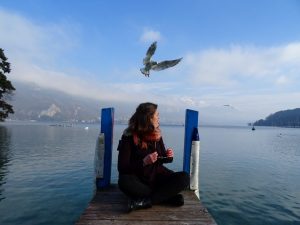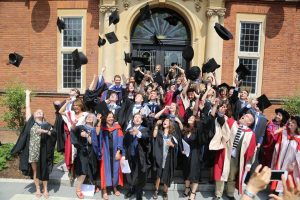“I enjoyed working with others as a team to tackle the story of “Der Fund” and present it in a new and interesting way that shows the creativity and diversity of the German Department as a whole. We were able to show that through our common knowledge of the German language, one story could be translated to an audience through a variety o

(from left: Sian Buller (Year 2), Sophie Allen (Year 3), Angelina Lotter-Jones (Year 3), Sophie Payne (PhD student), Emily Stanga (Year 3), Elisabeth Koenigshofer (OEAD-lecturer), Nick Bricknell (Year 1), © Regine Klimpfinger)
f means, be it speech, music, or paintings.” (Sian Buller, Year 2)
While the beast from the east had its icy claws around Reading, some of our talented German Studies students braved the cold and set out to present the outcome of this year’s German Studies
Project “Der Fund by Veza Canetti” at Christchurch Reading.
The project was a voluntary extracurricular activity that should help students to develop and foster their German language and creative skills. For this project, which focused on text transformation, students from all years read a short story by almost-forgotten Austrian author Veza Canetti and interpreted it in their own way through various media.
Sophie Payne, a PhD student in the department, was our host for the evening. She gave the audience an insight into the author’s life and led the Q&A after the recital of the translation.

(Emily Stanga, presenting her translation © Melani Schroeter)
Veza Canetti and her short story Der Fund
Author Veza Canetti, wife of Nobel Prize winner Elias Canetti, never stepped out of her husband’s long literary shadow but published extensively from the 1930s onwards. Born in 1897 in Vienna, she emigrated to London with her husband in 1938, fleeing the Nazis who had annexed Austria. During her life time, she published mainly short stories in Viennese working class newspapers but could not find a publisher for her novels. Those were only published from the 1990s onwards.
Her stories focus often on women from lower class backgrounds and their day-to-day struggles. Her short story Der Fund (The Discovery) is no exception, telling the story of Knut Tell, an impoverished poet who is forced to work at a lost property office. There, he finds the letter of an illiterate woman who had been treated ill by her former doctor and lover. Fascinated by her letter, Knut sets out to find her. Love, jealousy, and star-crossed lovers dominate this little gem.
Why Veza Canetti?
Veza Canetti is one of many forgotten female authors of the last century who worked alongside men but did not achieve fame. Like many other artists, Veza had been born into a Jewish family and therefore decided to flee to England when Hitler annexed Austria in 1938. She had worked as an English teacher before she moved to London. Veza was chosen because she reflects anniversaries that are commemorated in 2018: the centenary of women’s rights to vote and 80 years since the annexation of Austria and the dissolution of Austria as an independent nation.
Our students
Nick Bricknell, Year 1, used music to make the text accessible to the audience. During the presentation he played variations of Bach’s Wachet auf, ruft uns die Stimme Cantata 140 which reflected

(Sophie Payne, introducing Veza Canetti © Melani Schroeter)
the mood and events in Canetti’s text. Nick deliberately chose a lesser known work by a famous German-speaking composer. He has worked as a church organist at Christchurch since the beginning of his studies at Reading and impressed the audience with his skills.
Sophie Allen, Angelina Lotter-Jones and Emily Stanga, all Year 3, put their translation skills to practice and produced a great translation into English. All three worked hard throughout the last months and weeks because Veza’s language is quite different from what our students work on in their translation classes. During the presentation, all three translators read their texts aloud to the audience, accompanied by the organ recital.
Angelina: “Prior to this project I had not heard of Veza Canetti before and there was not an English translation in existence at the time we did this project. What attracted me to participating in this project was the opportunity to have more practice translating.”
Sophie: “I was able to use my methods from my university classes to write the translation, which involves envisioning the target audience and retaining the style of the text.”

(Sian Buller, Der Fund No.1 © Sian Buller)
Sian Buller, Year 2, proved herself as a visual artist. She created four canvases to accompany the narration. She chose a different style and media for each piece, for example acrylic paint, paint-pens and artist pencils. Her fascinating work added a visual dimension to the way in which a text can be interpreted.
Sian: “Through my participation in this project, I felt that I have learnt many valuable skills. I had to be organised and time efficient, in order to give myself enough time to complete each canvas to a suitable level of standard on time, whilst still keeping up with my own university work. I also needed to be conscientious whilst thinking of designs that would be clear to an audience and fit in with any narration or musical pieces created by other participating students. Additionally, I had to make sure that the pieces were captivating as they were used in advertised posters around the university and so served as a public representation for the project itself.”
All participants showed great interest in the project and dedicated a lot of time, energy and effort to their tasks. It is great to see that our students are so engaged and were able to transfer their skills to a new and experimental project. The audience on the evening of the presentation was small due to the weather condition but our students made it worth coming out that evening and the audience truly enjoyed the presentation.
If you would like to see their great work for yourself, the project is exhibited in room EM 274 (Resources Room) in the Edith Morley building.



















 Lucia Crowther graduated in 2015 with a degree in Italian and History of Art. An excellent and committed student throughout her degree, Lucia was the recipient of the Meneghello-Italianist UG Prize for outstanding academic achievements in Italian Studies. Her dissertation entitled ‘The architectural formalisation of pilgrimage in the portico of the Madonna di San Luca’ was awarded the prestigious British-Italian Society Memorial Rooke Prize for the best UG dissertation in Italian Studies in 2016.
Lucia Crowther graduated in 2015 with a degree in Italian and History of Art. An excellent and committed student throughout her degree, Lucia was the recipient of the Meneghello-Italianist UG Prize for outstanding academic achievements in Italian Studies. Her dissertation entitled ‘The architectural formalisation of pilgrimage in the portico of the Madonna di San Luca’ was awarded the prestigious British-Italian Society Memorial Rooke Prize for the best UG dissertation in Italian Studies in 2016.

 In Mexico, both 31st October and 1st November are big celebrations. Dr Catriona McAllister, who teaches Latin American history and culture, describes Día de muertos traditions for us: ‘On 2nd November (coinciding with the Catholic festival of All Souls Day), Mexico celebrates the Day of the Dead. The festival offers the opportunity to remember and honour departed loved ones and has its origins in pre-Hispanic traditions that were later combined with Catholic practices. Celebrations can take place over several days, and it is traditional to visit cemeteries where loved ones are buried and to prepare an altar at home. Altars usually contain a range of objects including flowers (particularly cempasúchiles, or marigolds), the favourite food of the departed loved one, candles, objects belonging to the departed, photos and decorated sugar skulls’.
In Mexico, both 31st October and 1st November are big celebrations. Dr Catriona McAllister, who teaches Latin American history and culture, describes Día de muertos traditions for us: ‘On 2nd November (coinciding with the Catholic festival of All Souls Day), Mexico celebrates the Day of the Dead. The festival offers the opportunity to remember and honour departed loved ones and has its origins in pre-Hispanic traditions that were later combined with Catholic practices. Celebrations can take place over several days, and it is traditional to visit cemeteries where loved ones are buried and to prepare an altar at home. Altars usually contain a range of objects including flowers (particularly cempasúchiles, or marigolds), the favourite food of the departed loved one, candles, objects belonging to the departed, photos and decorated sugar skulls’. To all students of Modern Languages and European Studies!
To all students of Modern Languages and European Studies!